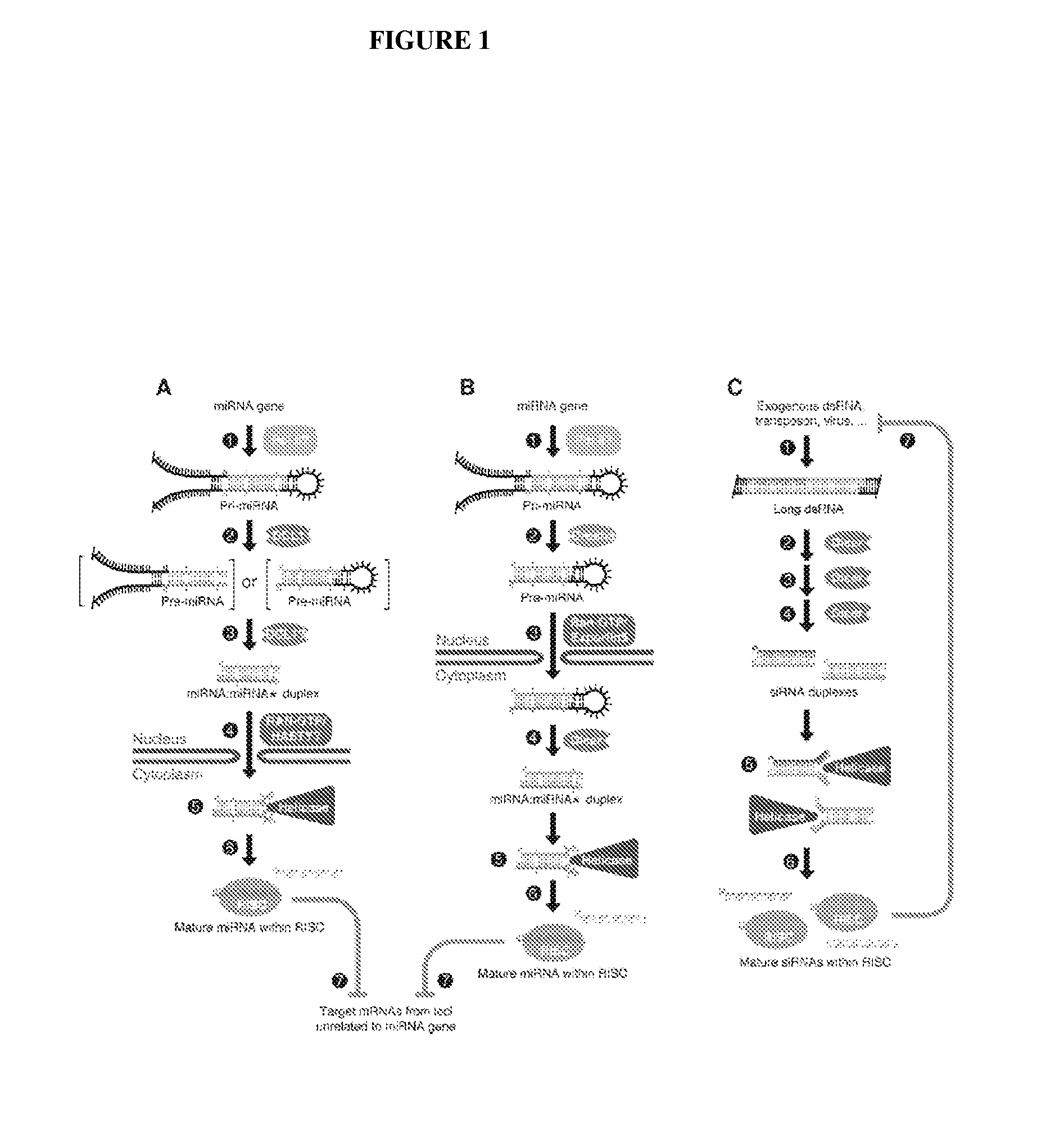Micrornas and uses thereof
- Summary
- Abstract
- Description
- Claims
- Application Information
AI Technical Summary
Benefits of technology
Problems solved by technology
Method used
Image
Examples
example 1
Prediction of MiRNAs
[0125]We surveyed the entire human genome for potential miRNA coding genes using two computational approaches similar to those described in U.S. Patent Application Nos. 60 / 522,459, Ser. Nos. 10 / 709,577 and 10 / 709,572, the contents of which are incorporated herein by reference, for predicting miRNAs. Briefly, non-protein coding regions of the entire human genome were scanned for hairpin structures. The predicted hairpins and potential miRNAs were scored by thermodynamic stability, as well as structural and contextual features. The algorithm was calibrated by using miRNAs in the Sanger Database which had been validated.
1. First Screen
[0126]Table 2 of U.S. patent application Ser. No. 10 / 709,572, the contents of which are incorporated herein by reference, shows the sequence (“PRECURSOR SEQUENCE”), sequence identifier (“PRECUR SEQ-ID”) and organism of origin (“GAM ORGANISM”) for each predicted hairpin from the first computational screen, together with the predicted mi...
example 2
Prediction of Target Genes
[0134]The predicted miRNAs from the two computational screens of Example 1 were then used to predict target genes and their binding sites using two computational approaches similar to those described in U.S. Patent Application No. 60 / 522,459, Ser. Nos. 10 / 709,577 and 10 / 709,572, the contents of which are incorporated herein by reference, for predicting miRNAs.
1. First Screen
[0135]Table 6 of U.S. patent application Ser. No. 10 / 709,572, the contents of which are incorporated herein by reference, lists the predicted target genes (“TARGET”) and binding site sequence (“TARGET BINDING SITE SEQUENCE”) and binding site sequence identifier (“TARGET BINDING SITE SEQ-ID”) from the first computational screen, as well as the organism of origin for the target (“TARGET ORGANISM”). Table 12 of U.S. patent application Ser. No. 10 / 709,572, the contents of which are incorporated herein by reference, lists the diseases (“DISEASE NAME”) that are associated with the target genes...
example 3
Validation of miRNAs
1. Expression Analysis—Set 1
[0141]To confirm the hairpins and miRNAs predicted in Example 1, we detected expression in various tissues using the high-throughput microarrays similar to those described in U.S. Patent Application No. 60 / 522,459, Ser. Nos. 10 / 709,577 and 10 / 709,572, the contents of which are incorporated herein by reference. For each predicted precursor miRNA, mature miRNAs derived from both stems of the hairpin were tested.
[0142]Table 2 shows the hairpins (“HID”) of the second prediction set that were validated by detecting expression of related miRNAs (“MID”), as well as a code for the tissue (“Tissue”) that expression was detected. The tissue and diseases codes for Table 2 are listed in Table 7. Some of the tested tissues wee cell line. Lung carcinoma cell line (H1299) with / without P53: H1299 has a mutated P53. The cell line was transfected with a construct with P53 that is temperature sensitive (active at 32° C.). The experiment was conducted at ...
PUM
| Property | Measurement | Unit |
|---|---|---|
| Fraction | aaaaa | aaaaa |
Abstract
Description
Claims
Application Information
 Login to View More
Login to View More - R&D
- Intellectual Property
- Life Sciences
- Materials
- Tech Scout
- Unparalleled Data Quality
- Higher Quality Content
- 60% Fewer Hallucinations
Browse by: Latest US Patents, China's latest patents, Technical Efficacy Thesaurus, Application Domain, Technology Topic, Popular Technical Reports.
© 2025 PatSnap. All rights reserved.Legal|Privacy policy|Modern Slavery Act Transparency Statement|Sitemap|About US| Contact US: help@patsnap.com



